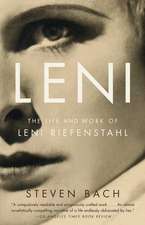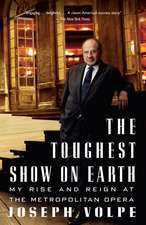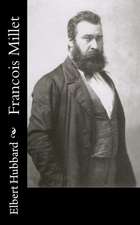Nureyev: The Life
Autor Julie Kavanaghen Limba Engleză Paperback – 31 oct 2008
Vezi toate premiile Carte premiată
Costa Book Awards (2007)
In this superb biography, Julie Kavanagh deftly brings us through the professional and personal milestones of Nureyev's life and career: his education at the Kirov school in Leningrad; his controversial defection from the USSR in 1961; his long-time affair with the Danish dancer Erik Bruhn; his legendary partnership with Margot Fonteyn at the Royal Ballet in London. We see his fiery collaborations with almost all the major living choreographers including Ashton, Balanchine, Robbins, Graham, and Taylor. And we see Nureyev as he reinvigorated the Paris Ballet Opera in the early 1980s before his death from AIDS complications in 1993. Nureyev: The Life is the most intimate, revealing, and dramatic picture we have ever had of this dazzling, complex figure.
Preț: 152.41 lei
Nou
Puncte Express: 229
Preț estimativ în valută:
29.16€ • 30.53$ • 24.13£
29.16€ • 30.53$ • 24.13£
Carte disponibilă
Livrare economică 15-29 martie
Preluare comenzi: 021 569.72.76
Specificații
ISBN-13: 9780375704727
ISBN-10: 0375704728
Pagini: 782
Ilustrații: 48 PAGES B&W PHOTOS
Dimensiuni: 157 x 233 x 43 mm
Greutate: 1.06 kg
Editura: Vintage Books USA
ISBN-10: 0375704728
Pagini: 782
Ilustrații: 48 PAGES B&W PHOTOS
Dimensiuni: 157 x 233 x 43 mm
Greutate: 1.06 kg
Editura: Vintage Books USA
Notă biografică
Julie Kavanagh is the author of Secret Muses: The Life of Frederick Ashton, which won the Dance Perspectives Foundation de la Torre Bueno Prize. She trained in ballet before taking up a career in journalism and has been arts editor of Harpers & Queen, a dance critic for The Spectator, and London editor of both Vanity Fair and The New Yorker. She lives in London with her husband and two sons.
Extras
Chapter 1: A Vagabond SoulEarly one morning when six-year-old Rosa Kolesnikova woke up, she remembered first of all that she was on the train, and then she noticed the three Nureyev girls sitting on the bunk opposite. The toddler was whimpering, and her eight-year-old sister was trying to comfort her. She saw to her annoyance that her friend Lilia, who was also six, had taken her toy and was clutching it. Their mother was nowhere to be seen. Something was going on. In the corridor people were rushing back and forth talking excitedly, but no one would say what was happening. Later she noticed that next door there were sheets curtaining off the Nureyev compartment and doctors in white coats were going in and out. Tyotya-Farida must be ill. Throughout the morning, making some excuse, she and the other children walked by to see if they could peek through a crack in the screen of sheets, but her mother would call them back and try to distract them. “Look, Lake Baikal! Lake Baikal! Isn’t it beautiful?” she cried.It was a cold, clear morning, and the lake, a sunlit ocean of ice, seemed to merge with the far-off white mountain ridges of Khamar Daban. For most of the day the train traveled along the southwestern shore beneath sheer cliffs and steep woods, offering sudden dazzling views of Baikal as it threaded through the tunnels. With its legend of the vengeful Old Man Baikal, who hurled a huge rock at his runaway daughter, the lake was a wonder for children: Its size alone was breathtaking—four hundred miles long and one mile deep in the middle. By late afternoon, however, its fascination had worn off, and everyone was glad to get to the Mongolian city of Ulan-Ude, where the train stopped for several hours.Almost all the passengers went into town to shop in the trading arcades and the poplar-lined main street, Leninskaya Ulitsa. When they returned, one or two of the women came up to the children with a large box and told them to look inside. There they saw a tiny baby swaddled tightly: “We bought him in Ulan-Ude,” they said, laughing. “It’s a little Tatar brother for the Nureyev girls!” Rosa found this hard to believe. It didn’t make sense that a Tatar child would be for sale in a place full of people who looked so foreign, with their big foreheads and slanting eyes. Besides, before they arrived, she had heard the adults talking about a new baby on the train. Rosa had a six-month-old brother of her own, but even so she was full of envy of the Nureyev sisters and tremendously excited. “We were all in ecstasies, and in the carriage there was such jubilation! It was like a holiday, with everyone happy and wanting to share in the celebration.”Word of the event spread quickly, and for the rest of the day people crowded into the carriage to see the new arrival: Rudolf Nureyev’s first audience. His birth, he would later say, was the most romantic event of his life, symbolic of his future statelessness and nomadic existence. It was to be a life lived mostly en route to places, navigated by what he called his “vagabond soul.” To Rosa he was never Rudolf or even Rudik, its diminutive, but Malchik kotoriy rodilsay v poezde said in one breath as a name: The-boy-who-was-born-on-a-train.The order for the soldiers’ families to leave had come suddenly. Almost full term in her pregnancy, Farida Nureyev knew she was taking a risk by traveling at this stage, but she had had no choice. For the last two months, Farida and Ekaterina, Rosa’s mother, had regularly gone together to the authorities to find out when they were going to be permitted to join their husbands, who were serving in the Red Army’s Far Eastern Division. One delay had followed another until at last, at the beginning of March 1938, the wives were told that a military train would be leaving that night.The children were asleep by the time the trucks arrived, and after waking them and bundling them in blankets, Farida left the barracks of Alkino, her home for the past nine months, and started for the station in Ufa, about forty kilometers away, where the train was waiting. There were two carriages set aside for the women and children, and a special wagon for their luggage. The compartments opened straight onto the corridor without the privacy of doors, but they were clean and quite comfortable, with an unoccupied single row of bunks on the opposite side, which all the children on the train immediately converted into a play area. “It was the best of times! There was such a spirit of adventure and excitement.” Most of the wives were young, already friends, and delighted to be going to their husbands, whom they hadn’t seen for several months. They were all very kind and solicitous toward Farida, making sure she had everything she needed, and each day one of the two doctors on board would come and check up on her.The train traveled at varying speeds, sometimes racketing along, sometimes stopping for hours while waiting to be hooked up to another engine. At stations there was usually a straggle of babushki selling little piles of wares—scallions, pickled gherkins, curds, smoked fish— but the women rarely bought anything, as the soldiers appointed to take care of them brought them provisions as well as hot water for tea and for washing. The children would have liked to get out and run along the platform, but their mothers were reluctant to let them go: They never knew when the train was going to leave. After nearly two weeks of traveling, everyone was growing restless, “Is the Far East far?” became the children’s endless refrain. “That’s why the day the little boy was born stuck in the memory. Given all the monotony, expectation, and boredom, you couldn’t forget such an event in a lifetime.”Rudolf Nureyev was “shaken out of the womb” as the train ran alongside Lake Baikal around midday on March 17, 1938. Farida was euphoric. Not only was the baby born safely, but at last she had the son her husband longed for. When the train stopped in Ulan-Ude, she asked one of the women to accompany her eldest daughter, also called Rosa, a solemn, responsible girl, to send a telegram to her husband, Hamet, with the news, even though she felt sure he wouldn’t believe it. Once before, when her second daughter, Lilia, was born, Farida had sent word that she had given birth to a boy—“She lied because she longed to make him happy,” Rudolf wrote in his memoir. It is far more likely, however, that as Hamet’s work kept him away for long periods, her motive was to persuade him to return to their village. If so, it worked. “Overjoyed, Father came home on leave as soon as he could and found out that the ‘boy’ was Lida [Lilia]. He was speechless and utterly miserable.”By 1938 Farida had been married to Hamet for nearly nine years, although they had spent much of that time apart. When they first met, in the city of Kazan in the late twenties, he was still a student, studying Tatar philology and the new ideology of Communism at the academy there. He was not then the rigid army officer he later became, but a debonair young man full of ambition and ideals. A studio portrait of Hamet at twenty-five, dressed in pinstripe trousers, dress shirt, and bow tie, shows him sitting at a café table with an equally handsome friend, cigarette in hand; they look like a pair of Parisian flaneurs. Two years younger than Hamet and also of slight build, Farida herself was extremely attractive, with long sleek black hair parted in the middle, and dark round eyes. She rarely laughed, but had a quiet sense of humor that showed in her wry, closed smile: “It came from inside as in a Rembrandt picture.” Although she had no education, she was bright and, like Hamet, self-confident and proud, giving relatives the impression that they both considered themselves a touch above their families.The couple could not have chosen a more romantic place for their courtship than Kazan, with its elegant arcades and parks, and its skyline of minarets. There was a summer theater, a bandstand and chairs, the beautiful fountain encircled with birch trees in the Lyadskoy Gardens, and the limestone-white kremlin on the hill from which one could look down at the boats far below on the Kazanka River. They both retained their nostalgia for the city, and years later would sing such Kazakh duets together as the “Tower of Kazan,” a plaintive ballad about the Tatar queen who chose to jump to her death from its upper terrace rather than forsake her birthplace. Before the revolution, Kazan had ninety-one houses of worship— monasteries, mosques, and cathedrals—but by 1928, when Hamet and Farida were living there, many had been demolished by the Bolsheviks or were being used as administrative and storage buildings. Although brought up as Muslims—Hamet’s father was a mullah—both were now party members, having been more than willing to exchange their religious beliefs for faith in the Communist regime. For them, as Rudolf said, the revolution was “a miracle,” opening up the possibility of educating themselves and sending their children to university, an opportunity previously undreamed of by peasant families.Tugulbay, where Farida was born in 1905, was a large, relatively wealthy Tatar village near Kazan. Most households had a cow, but her parents, the Agilivulyevni, were poor, as there were four daughters and only one son to work the land. Farida’s brother, Valiula, was fifteen years older than she, and when their mother and father died during the typhus epidemic, he took her and her three sisters—Gafia, Gandalip, and Sharide—to live with his family in the city. Valiula’s second wife, who was much younger than her husband, resented the sudden arrival of the four girls and loaded them with domestic chores. He, on the other hand, was kind and caring, and did everything he could to make them happy. Valiula had a phonograph and encouraged his sisters to sing and dance, and he sent them to school. Farida received an elementary education, learning to read and write in Arabic (but not in Russian), and left with no special qualifications. At first she worked for her sister-in-law as a nanny, but there was a good deal of conflict between them. Then, in the early twenties, during the period of NEP—the New Economic Policy, which encouraged private enterprise—Valiula opened a bakery-restaurant near the Kirov Gardens, where all the sisters helped out. They loved being there: It meant that they were never hungry, and sometimes there were so many relatives sitting at the tables that there was no room for customers. Farida became an excellent cook, producing kabartmi (fried round cakes) from salty dough, and mastering the technique of making pelmeni, a type of ravioli, which remained her specialty. She was, her family claims, “very good at attracting customers,” and would stand at the stall outside the restaurant singing out her wares to passersby. One of whom might well have been twenty-five-year-old Hamet Nureyev, who claimed to have fallen in love with Farida “because of her good looks and sweet musical voice.”In his Bashkirian village of Asanova, Hamet was known as Nuriakhamet Nuriakhametovich Fasliyev, the son of Nuriakhamet Fasliyevich Fasliyev. Saying he “wanted to be different,” he chose to use the shortened “Hamet” and to combine his patronym with his surname when he left for the city. As children he and his brother, Nurislam, attended the local madrassa until 1917, when the Bolsheviks closed it down, at which point fourteen-year-old Hamet went to the village school for the next four years. His father, although no longer permitted to hold services, and forced to work in the fields, continued to be thought of as the mullah by the locals, most of whom still observed Muslim traditions and festivals.With their two sons and three daughters—Saima, Fatima, and Jamila—the Fasliyevs lived in a long narrow wooden isba at the edge of the village, the largest house in Asanova. It was a comfortable existence, with animals in the barns and rows of vegetables growing in the backyard. Across the dusty road was the Karmazan River, where the children spent so much of their time, swimming and fishing all summer in the bend where the water was deep and clean, and skating when it iced over in the winter months. During these long dark evenings the family gathered for music sessions, singing folk songs and dancing to Hamet’s accompaniment on the accordion or harmonica. Sometimes, on a fine day, he sat on a bench outside the house and played for the local children, who sat cross-legged or danced around him.In contrast to their neighbors, many of whom were illiterate, the Fasliyevs were one of the most educated families in the village. The siblings were encouraged to work hard, which Hamet did obsessively: “Studying was his passion.” In 1921, when the famine years began, the school was shut down and the sole priority became the search for food. Asanova’s mortality rate rose by the day; some villagers were forced to exist on libeda, a kind of gruel made from grass. Hamet had no choice but to join the workers in the fields until conditions improved. By 1925 he was working as an isbach in charge of the village club, organizing lectures on political issues, stocking the small library with propagandist literature, and arranging social evenings with dances and films. All the same he was restless. At twenty-two, he knew there was nothing but a peasant’s life for him in Asanova, which to this day remains a backward village of primitive shacks. He felt he had to escape. Young people were migrating to the cities to work, and Hamet wanted to be one of them. Kazan, the Tatar capital, a center of science, culture, industry, and commerce, was the obvious place to go. Deciding that military life was where his future lay, Hamet joined Kazan’s cavalry school as a private in charge of horses; but either too impatient or too proud to work his way up through the ranks, he left after two years to continue his studies, enrolling at the Tatar Academy.Farida, who met him at this time, had set her heart on going to the teachers’ training college on the wide boulevard of Gruzinskaya Street, and when she married Hamet in May 1929 he promised her that after his course was completed it would be her turn to study. By the end of that year, however, Farida was pregnant, and by the following summer they had left Kazan for good. It had begun to look as if the promise the city had offered them had failed. Following the arrest in 1928 of Sultan Galiev, a prominent supporter of Muslim Communism appointed by Stalin, a number of other leaders of the republic—teachers, intellectuals, and writers—were being prosecuted. Tatar autonomy was under threat and, uneasy about the outcome, Hamet decided to take his new wife back to his village. Stalin had just announced a radical switch from individual peasant farming to mass collectivization, and seeing in the changes an opportunity for self-advancement, Hamet volunteered himself as a senior worker in the Karmazan kolkhoz, Asanova’s state farm.
From the Hardcover edition.
From the Hardcover edition.
Recenzii
“Julie Kavanagh distills the fabulous spirit of Nureyev, the ballet world's first pop icon.”
—Vanity Fair
“Ferociously concrete, ambitious, profligate, shocking and soaring. . . . Nureyev is easily the best biography of the year.”
—The Philadelphia Inquirer
“The definitive biography of ballet's greatest star whose ego was as supersized as his talent.”
—Tina Brown
“A treasure trove for those intrigued by Nureyev the dancer, filled with thoughtful reflections on his technique, details of his roles, and of his encounters with ballet greats.”
—Seattle Times
“Kavanagh chronicles [Nureyev] with even-mindedness and original research and a mastery of detail. . . . And that is what we get: not a tell-all, but a tell-everything.”
—The New York Observer
—Vanity Fair
“Ferociously concrete, ambitious, profligate, shocking and soaring. . . . Nureyev is easily the best biography of the year.”
—The Philadelphia Inquirer
“The definitive biography of ballet's greatest star whose ego was as supersized as his talent.”
—Tina Brown
“A treasure trove for those intrigued by Nureyev the dancer, filled with thoughtful reflections on his technique, details of his roles, and of his encounters with ballet greats.”
—Seattle Times
“Kavanagh chronicles [Nureyev] with even-mindedness and original research and a mastery of detail. . . . And that is what we get: not a tell-all, but a tell-everything.”
—The New York Observer
Premii
- Costa Book Awards Nominee, 2007












